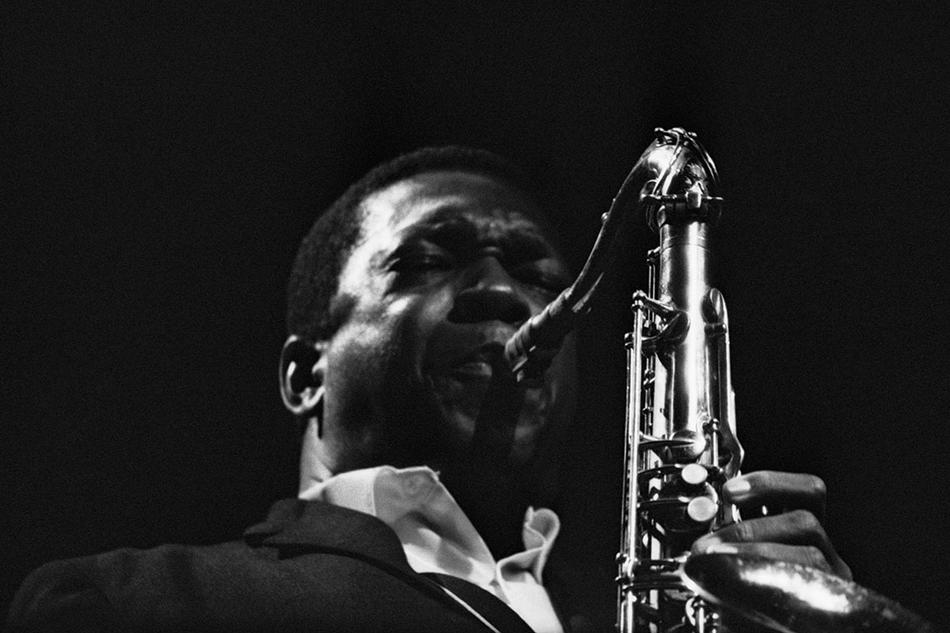Saxophonist John Coltrane's legacy includes one of the most profound bodies of work in jazz and one of its least likely careers. While most of the music's key figures established their presence relatively young, Coltrane went virtually unnoticed until he turned 29. He first gained attention in 1955 when he joined what became the first classic Miles Davis Quintet and the jazz world gained its initial familiarity with his complex if unfinished tenor sax technique that delivered a charged, unyielding tone. When the trumpeter fired Coltrane in early 1957 for bringing his drug and alcohol habits onto the bandstand, Coltrane risked becoming little more than a footnote to a rich jazz era, another musician who succumbed to addictions all too prevalent in the period.
Instead, as Ben Ratliff ’90CC recounts in Coltrane: The Story of a Sound, Coltrane became a genius and a saint. After kicking his habits through what he later described as a spiritual awakening, Coltrane joined pianist Thelonious Monk’s quartet in 1957 for a legendary stand at New York’s Five Spot Café, and then rejoined Davis for a two-year stretch best remembered for the epochal 1959 LP Kind of Blue. The promise of Coltrane’s previous work was now realized through a virtuosity of conception and execution that remained extravagant and became even more ambitious. The complexities of his harmonic elaborations and rhythmic juxtapositions drew notices that marked him as emblematic of the period’s most challenging art. His approach was labeled angry, in the manner of the young playwrights then revolutionizing the theater, his torrential arpeggios “sheets of sound” that flowed as aural equivalents of abstract expressionist canvases. The album Giant Steps, his 1959 magnum opus, defines advanced improvisation over a rapidly shifting harmonic foundation to this day.
When Coltrane organized his own quartet in 1960, the music became both formally simpler and more socially resonant. The many choruses of twisting, cascading arpeggios became even lengthier soliloquies over the thick polyrhythms of Elvin Jones’s drums and pianist McCoy Tyner’s tolling of the modes and scales that Coltrane had begun to explore with Davis. When Coltrane added a new sound to his arsenal with the long-neglected soprano saxophone, what became the classic John Coltrane Quartet established itself quickly with its recording of Rodgers and Hammerstein’s “My Favorite Things”; but the bulk of its repertoire announced an identification with non-Western music (“India,” “Africa”), religiosity (“Spiritual,” “Dear Lord”), and the civil rights movement (“Alabama,” “Up ’Gainst the Wall”). As his performances grew more prolix and intense, Coltrane’s aggressive approach was characterized as a soundtrack to the protest movements of the period. He became a bellwether, labeled “anti-jazz” by traditionalists (among whom were several prominent jazz critics), and celebrated as the harbinger of a new era by a growing audience mesmerized by his and his band’s music. Ratliff correctly labels this period “Vanguard,” and not just to honor the nightclub that provided the scene for Coltrane’s most famous live recordings. The accolades that greeted A Love Supreme, the Quartet’s 1964 masterpiece (and, according to Coltrane’s own liner notes, his thanks to God for the new life he began pursuing in 1957), were a rare demonstration of innovation converging with popular acceptance.
Yet Coltrane remained restless, and by mid-1965 was moving even further from fixed rhythms and tonalities, into combustible exhortations with religious overtones (“Ascension,” “Meditations”) that expanded the basic quartet by adding younger players lacking both Coltrane’s grounding and his command of jazz tradition, a situation that quickly led Tyner and Jones to leave the band. The change may have been generated in part by practical considerations. Coltrane was beginning to succumb to the cancer that claimed his life two years later at age 40, and may have needed the extra voices to sustain a style of playing that would soon be characterized as “energy music.” But it also fit his profile of the ever-questing, unfulfilled seeker. Even longtime supporters began to question his new direction, but they ultimately took solace in their assurance that, had Coltrane only lived, his commitment would have led him to an acceptable aesthetic resolution.
Ratliff, a music critic at the New York Times, wisely sees that there are two stories here — what Coltrane achieved and how he was and continues to be received. He divides his narrative accordingly into two roughly equal sections. The first contains a serviceable journey through the recorded legacy, as open to question as any subjective selection might be, but nonetheless effective in charting the technical and conceptual hegira that Coltrane pursued during his tumultuous creative decade. The second addresses not just the critics and theorists of varying agendas who made Coltrane a cause célèbre, but also the fans who obsessively taped his performances (the library of bootlegged Coltrane may even exceed that of Charlie Parker) and the generations of young musicians who have been in thrall to his now-codified techniques. What results, like Coltrane’s music, is a mixed bag.
Ratliff makes several important points, especially in his discussion of how Coltrane’s music confronted the conventions of both recording and live performance. The temporal limits of the long-playing record in documenting Coltrane’s music are clear enough, but Ratliff is even better at underscoring how Coltrane tested what at the time was the standard 30- or 40-minute length of nightclub sets. In practical terms, this was Coltrane’s most immediately revolutionary act: to create an aesthetic that was both incapable of being accurately documented on a 20-minute album side and inimical to the business interests of club owners and concert producers. The form of the music challenged the powers that be as much as its content. When asked about whether he and Coltrane ever discussed such matters as the relative merits of Martin Luther King and Malcolm X, saxophonist Archie Shepp once said that “the only political discussions we ever had were about the music business.” Ratliff emphasizes how Coltrane’s most radical stance may have been vis-à-vis the jazz world’s means of production.
Other important matters get lost in a deluge of reinforcing interviews and Ratliff’s justifiable dissatisfaction with the negative impact of Coltrane the prolix technician on many musicians who followed. We lose sight of the man who often retreated backstage to practice while others soloed, and who frequently diverted the political and spiritual queries of interviewers to focus on music. (Commentators rushed to link Coltrane with various belief systems as third world and religious references proliferated in the song titles of his final years, and especially after his widow, Alice Coltrane, founded an ashram; yet the religious figure called to mind by the Coltrane work ethic is John Calvin.)
Ratliff captures the tumult of Coltrane’s music and the responses it continues to generate, and underscores the shifts in approach that continue to make Coltrane such an important contemporary influence. At the same time, Ratliff underplays a few major issues. While the book’s subtitle promises a focus on sound, he spends too little time on either the aural attraction of Coltrane’s tenor and soprano saxes or the collective voice of his Quartet. There is a story in Coltrane’s sound, but Ratliff only begins to tell it.



